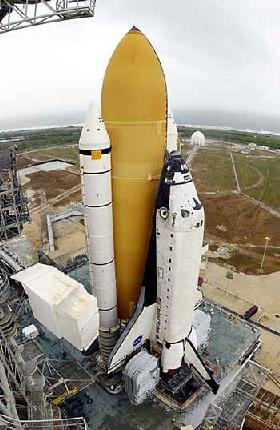Before the launch of the ferry - a short profile of Ilan Ramon

He was chosen for the position by the Air Force, following an agreement - signed in 1995 between Israel and the US - to include an Israeli astronaut in a NASA space flight, as well as to include an Israeli experiment in the shuttle. The Israel Space Agency asked the Air Force to choose the participant for it, and in '98 the Air Force chose Ramon. In the space shuttle Columbia mission, Ramon will serve as a "Payload Specialist". However, piloting knowledge is not part of the requirements for a cargo specialist.
Ramon was born on June 20, 1954 in Ramat Gan. He grew up in Be'er Sheva, where his parents still live today. In 1974 he completed the pilot course in combat. At the beginning of his career in the Air Force, Ramon was a Mirage and Skyhawk pilot. After that, he was among the first fighter pilots who went to the US to learn to fly the F-16 and was part of the team that received the plane in the Israeli Air Force. In 1981, Ramon was among the pilots who participated in the attack on the reactor in Iraq. After that he commanded a Phantom squadron and an F-16 squadron. His last position in the force was the head of the munitions department.
His main role will be on the Columbia shuttle to operate from space as part of an experiment, MEIDEX, an Israeli experiment designed at Tel Aviv University, and its purpose is to study how dust storms affect the climate of the Middle East.
Also, Ramon will participate in conducting additional experiments on the shuttle, including an experiment by the European Space Agency, which will investigate the effect of space conditions on the respiratory system; Studying the effect of the microgravity conditions in space on plant cells; The effect of microgravity conditions on bacteria - how does weightlessness affect the physiology of bacteria and fungi and what effects does weightlessness have on metabolism and fungal sensitivity to antifungal drugs; Research that will try to improve the understanding about the development of kidney stones; Experiments by high school students, including an experiment by "Ort" high school students from Kiryat Motzkin.
Ramon has a bachelor's degree in electrical and computer engineering from Tel Aviv University. He is married and the father of four children, who joined him during the training period at NASA.
The astronauts will receive fresh food and sleep in sleeping bags
By Tamara Traubman, Haaretz, Walla News!
Astronaut flights into space require meticulous preparations, which last for many months by hundreds of NASA employees. The astronauts' daily schedule is carefully planned: each astronaut has his own schedule, which determines what he will do every minute on the shuttle, when he will perform each of his tasks, when he will eat, when he will sleep and when he will defecate.
The days of the 70s when astronauts were fed small, crumbly food cubes are long gone. Astronauts today enjoy a varied menu as well as fresh food.
For example, Col. Ilan Ramon's first lunch in space will include chicken (kosher) and noodles, as well as green peas and mushrooms, strawberries, brownies and orange juice.
Sleeping on the ferry is usually done in sleeping bags. The astronauts have to tie themselves to sleeping berths, or to the pilot's chair and the crew chief, so that they don't fly inside the cabin.

One response
Ilan was the bravest man in the world